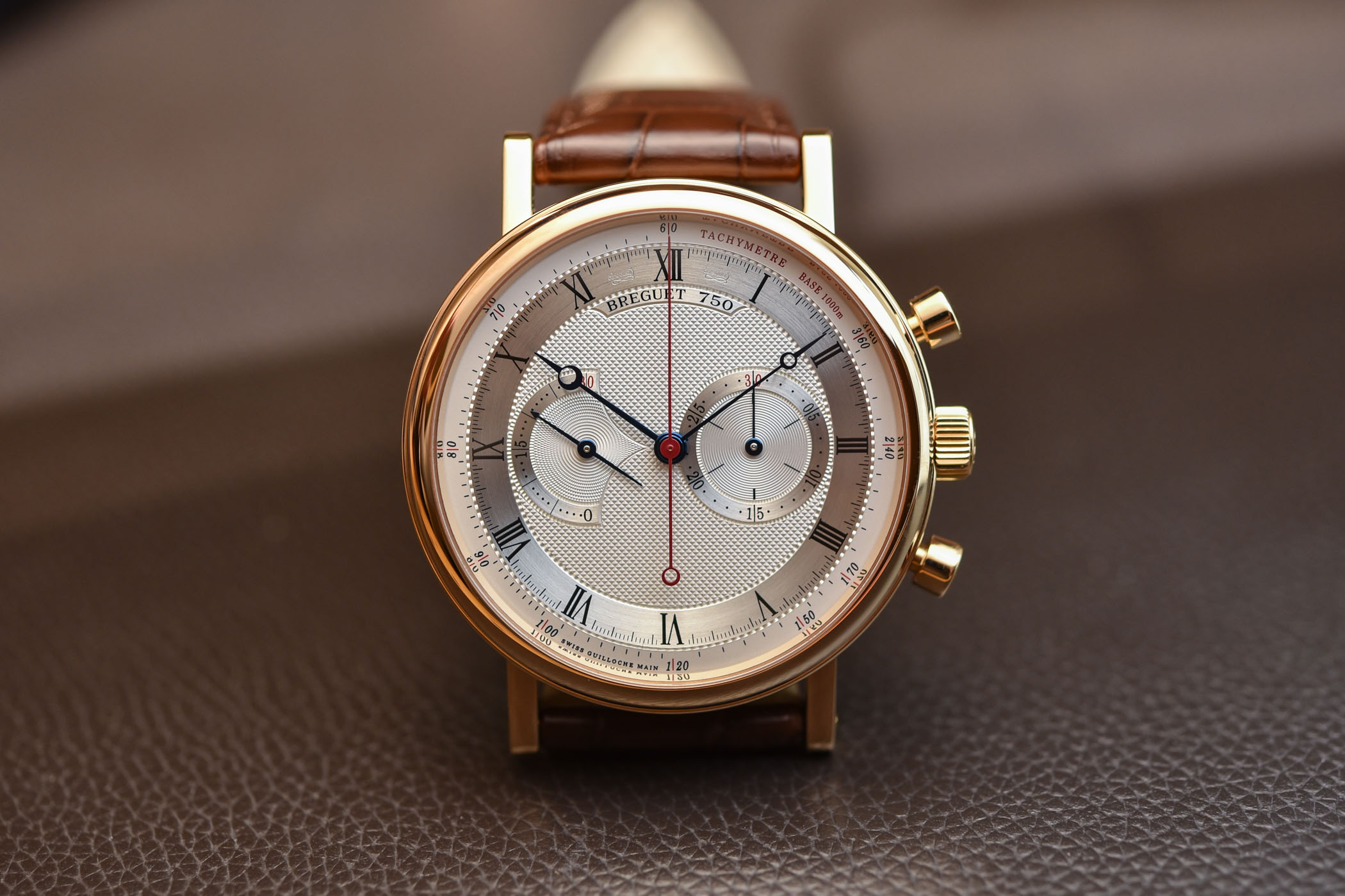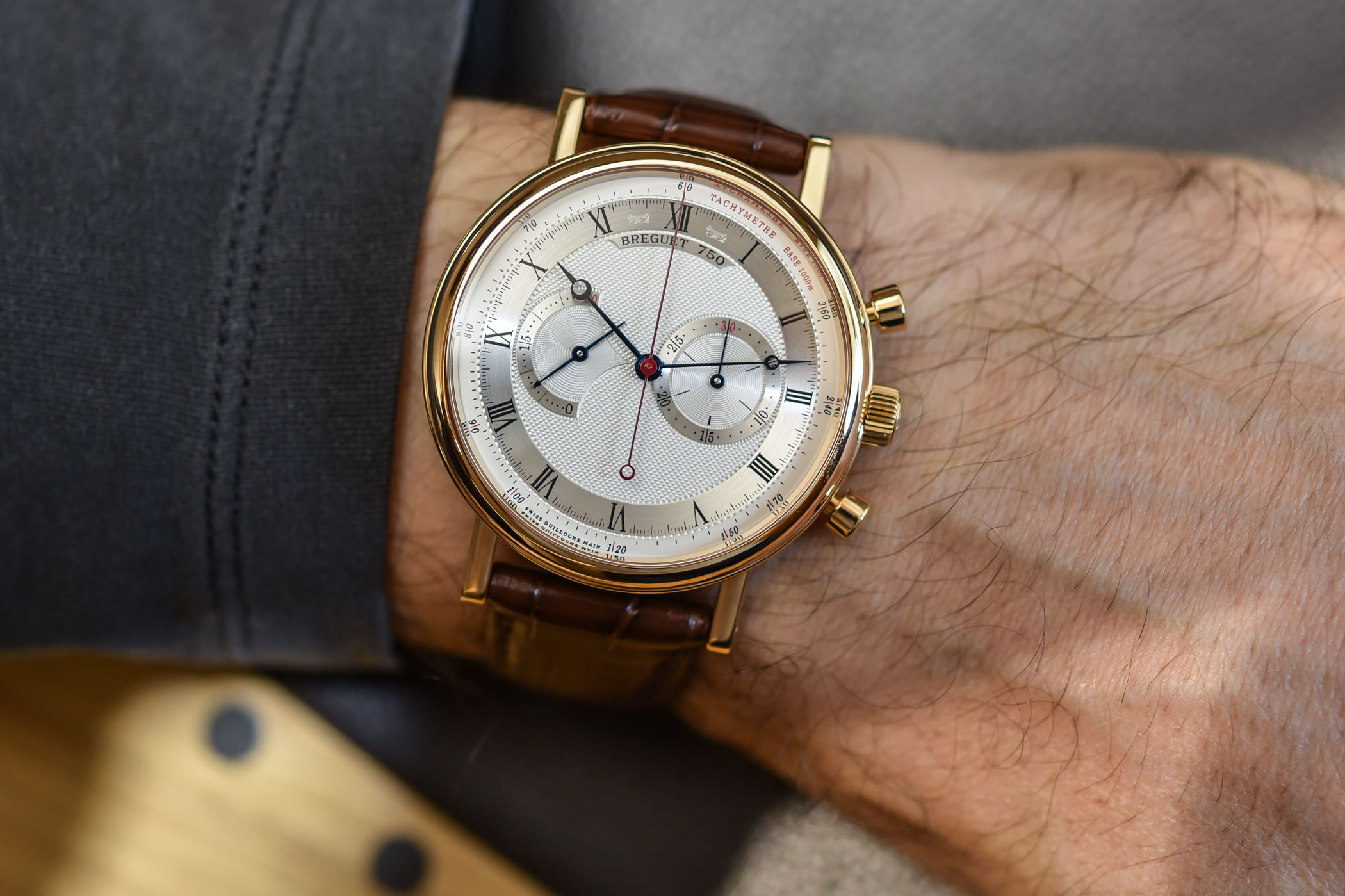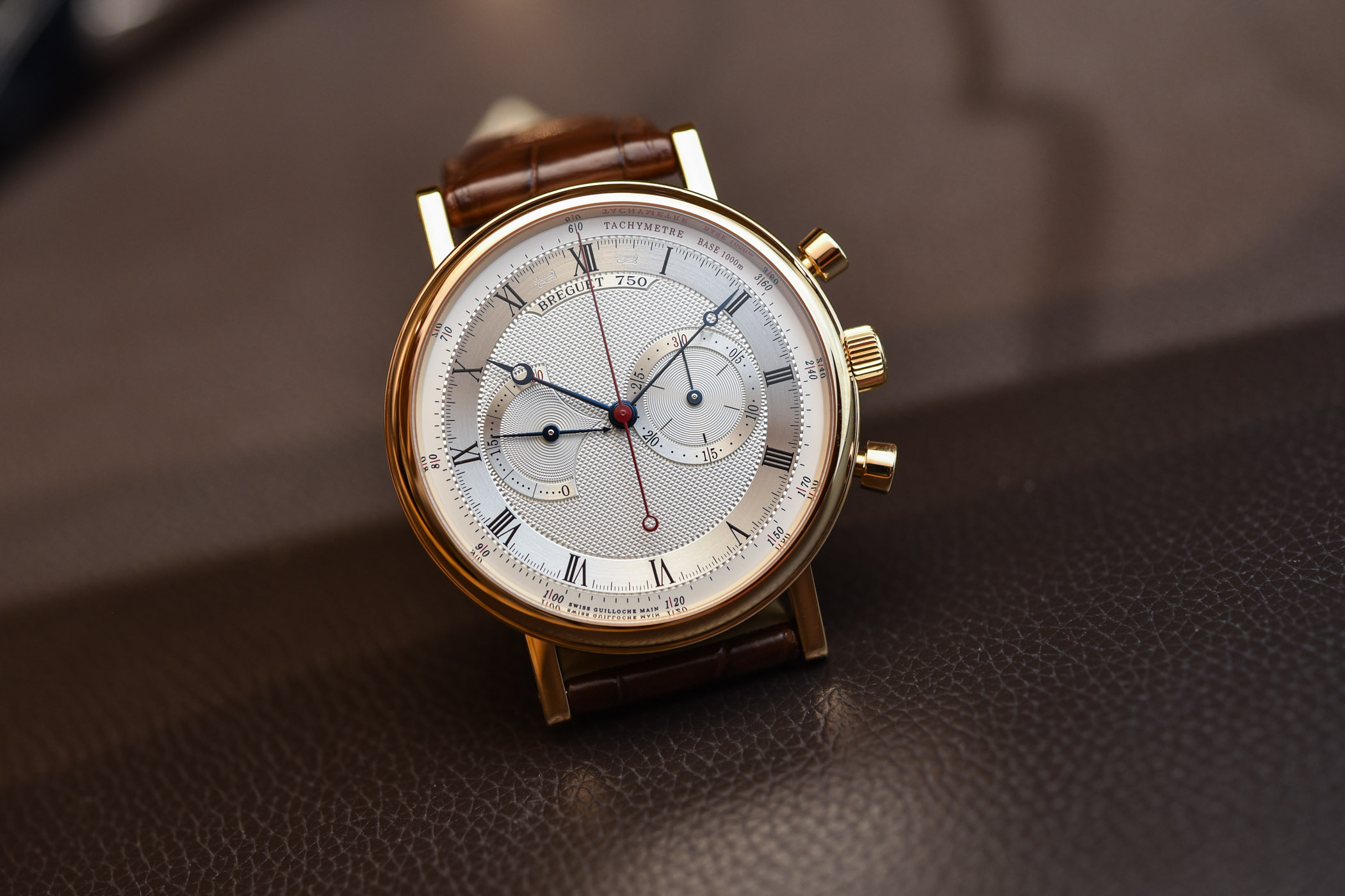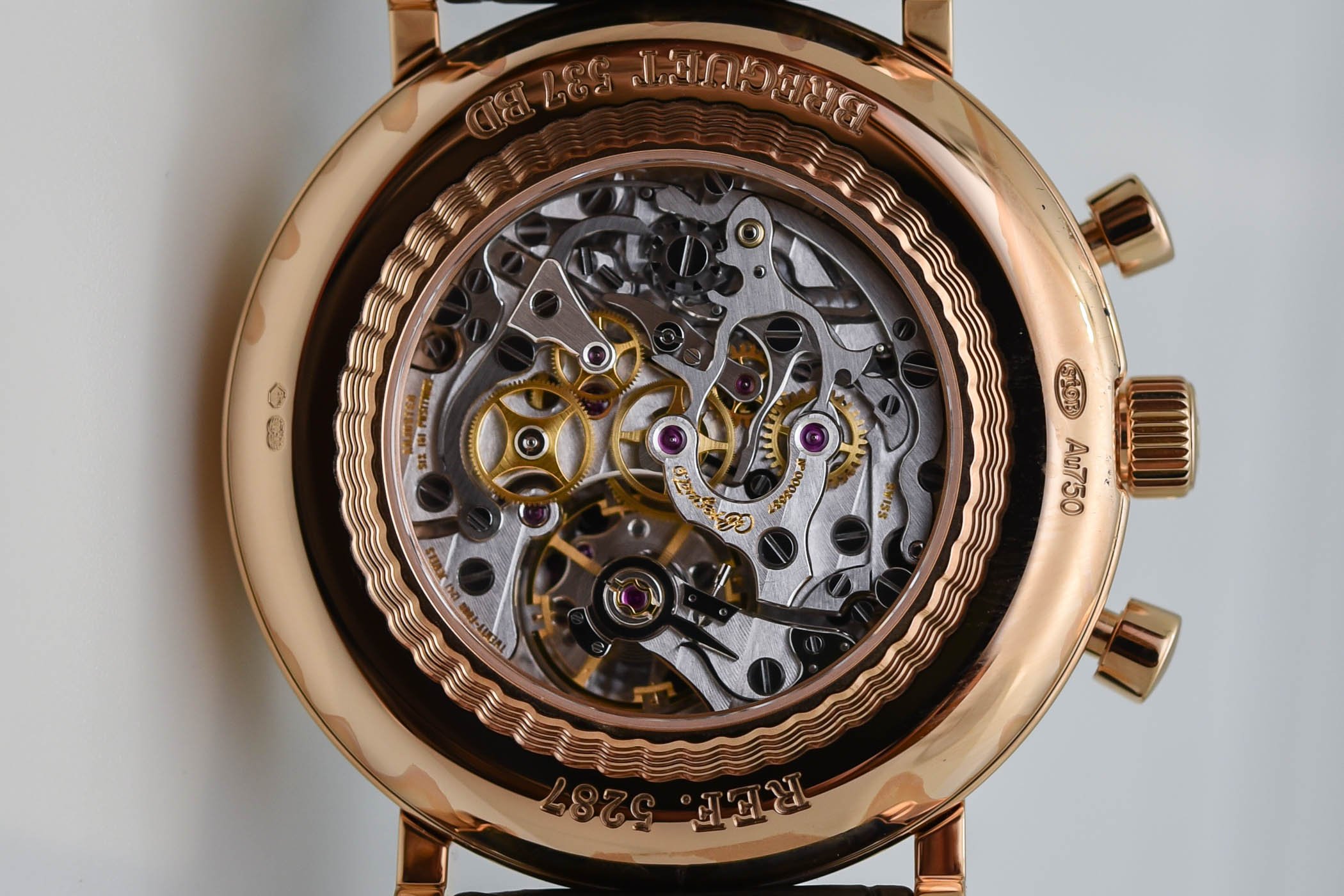The Breguet Classique 5287, with a Superb Hand-Wound Lemania Chronograph Calibre
Celebrating the beauty of a contemporary legend.

Instead of unveiling a brand new 2020 model hot off the production line, today is all about indulgence as we revisit a timeless beauty: the Breguet Classique Hand-Wound 5287 chronograph. Although it was originally introduced in 2013 and still available in some boutiques, it is no longer being produced. This probably means that the Classique 5287 will join the circuit of coveted collector’s pieces and see its price and desirability skyrocket. A classic in every sense of the word, from its refined aesthetics to its iconic hand-wound, Lemania-based chronograph movement, we were fortunate to have the rose gold model for our hands-on session.
How Breguet recovered its radiance
Without re-examining the fascinating legacy of founder Abraham-Louis Breguet, it is worth dedicating a few lines to the recent history of the brand when it was acquired by Nicolas G. Hayek, founder of Swatch Group, in 1999. And Lemania has a lot to do in this story.
Lemania was founded in 1884 by Alfred Lugrin. In 1932, due to hard times for the watch industry, Lemania joined the SSIH Group (which would later become the Swatch Group), alongside Tissot and Omega, resulting in close collaborations between these brands and the movement manufacturer. Facing difficulties in the late 1970s due to the quartz crisis, SSIH had to get rid of its high-end Lemania branch in 1980. The following year, Lemania was acquired by Piaget, with drastic cuts in the workforce and was renamed “Nouvelle Lemania SA”. It continued to create high-end, ultra-thin movements and to deliver its beautiful hand-wound chronographs to some of the most respected brands (Patek, Dubuis and Vacheron, for example).

In 1992, Investcorp, the owner of Breguet back in the days, took over Nouvelle Lemania SA. In 1999, Nicolas G. Hayek acquired Breguet and, coincidentally Lemania, which was producing all Breguet watches at that time, in addition to movements for third-parties. In 2009, Swatch Group decided that Lemania had to stop delivering movements to its competitors and to focus exclusively on Breguet. The name Lemania was changed to Manufacture Breguet. As such, Breguet’s current manufacture has been built on the foundations of Lemania.
Case and Dial
The founder’s preference for simple, neo-classical style cases, eschewing the highly ornate case designs of his day, is reflected in the round case of this Classique 5287 with straight lugs welded directly onto the caseband. The only concession to decoration on the case is by way of the fluting on the caseband, one of the ‘unmistakable signs’ of the House and originally used on pocket watches to enhance grip. The gleaming 18k rose gold case measures 42.5mm and has a thickness of 12.1mm. Perhaps not as small as some purists would like, it does, however, offer a generous view – and there is a lot of viewing pleasure on this 5287.
If there is one technique that is synonymous with Breguet, it is guillochage. There might be other Maisons that employ guillochage, but A.L. Breguet was the first to apply engine-turned motifs to his watch dials to delineate different functions and improve the legibility of the dial. The technique has barely changed since Breguet’s days and guillocheurs in Breguet’s manufacture still rely on historic rose engine lathes operated by hand. You can get a feel for what this entails in our article and this short video filmed at Breguet. Starting life as a solid 18k gold blank, an engraver hollows out the areas on the dial that will feature guillochage. Here you can see the central part of the dial has been decorated with a hobnail pattern while the small seconds at 9 o’clock has a circular barleycorn motif and the 30-second totaliser at 3 o’clock features snailing. It’s surprising how this technique manages to set apart and distinguish each function and provides a matte glare-free background – an important consideration for a chronograph.
The elegant Roman numerals for the hours are set against a circular brushed track and the tachymeter scale is discreetly integrated on the outer perimeter with a grey and white chequerboard track. A sporty touch of red appears on the central chronograph seconds hand, the inscription ‘TACHYMETRE BASE 1000m’, on the bar separating the numbers on the scale, as well as on the number ‘30’ in both sub-dials.
But what makes this dial so different, and so charming, is the way that the left counter for the small seconds is missing a chunk of its circumference. Instead of being circular, an elegant sweep has done away with parts of the right side to form a pointy beak. It reminds me so much of a stylised bird’s head, with its blue eye and crest, that once you see it it’ll be hard to ‘unsee’. Another idiosyncratic touch is that instead of having the conventional 0-60 for the running seconds, only 0-30 are represented with 0 at the bottom and 30 on top. The double blued hand has an arrow on one tip and a glides enticingly close to the central axis.
The classic Breguet open-tipped hands are made in hardened and tempered steel, polished and then thermally blued while the central chronograph seconds hand is made from a non-magnetic alloy and lacquered red. Naturally, the secret signature, another feature common to all Breguet watches, is engraved on either side of the XII marker and the individual serial number – 750 on this model – is stamped on the cartouche at 12 o’clock and also on the caseback.
The Calibre 2310, or chronograph heaven
As mentioned earlier, Breguet’s latest chapter has been built upon very solid foundations after acquiring the historic Lemania manufacture. Renowned for its outstanding watch movements, in particular chronographs, stopwatches and repeaters, Lemania once provided chronograph calibres for the big names in the business. One movement, in particular, designed by Albert Piguet at the Lemania workshops in the early 1940s, would achieve legendary status: the CH 27 or Calibre 2310.
Initially known as CH 27, and later with updates as the Lemania 2310 (in bi-compax layout), this sophisticated column-wheel chronograph calibre was used, among others, by Patek Philippe (CH 27-70), Vacheron Constantin (calibres 1141 and 1142) and Omega’s early Speedmaster (calibre 321), the famous Moonwatch – and revived recently. In fact, it was used in many of the finest hand-wound chronographs from the 1940s until quite recently when brands invested massively in manufactures to develop their own movements.
With its reputation for endurance and reliability, calibre 2310 is also admired for its beautiful architecture. Beyond customisation tweaks performed by brands, the ‘y’-shaped bridges are hallmark features of this calibre. You can see the chronograph pillar or column-wheel – the brain of the watch – in the bottom section of the movement responsible for controlling the movement of the hammers, levers and clutch. In the centre the contrasting gold-coloured gear train and at the top the balance wheel with its swan-neck regulator.
Breguet has contributed its special touch to the mechanics and enhanced precision with a free-sprung Breguet overcoil and Breguet balance spring adjusted in 6 positions. Breguet has also gone to town with the finishes. Geneva stripes on the bridges, anglage, polished screw heads and slots, perlage on the base plate, a complete finishing of the chronograph’s gears and levers – in short, no corners have been cut to make this movement as refined as humanly possible. With 24 jewels, a 3Hz frequency and a power reserve of 48 hours, it might not be the most modern movement in the industry today but it retains its reputation as one of the most beautiful ever made.
Availability and Price
The Breguet Classique Chronograph 5287 in rose gold comes with a brown leather strap and a triple-blade folding clasp. As mentioned earlier, it is no longer produced but still available in some Breguet boutiques worldwide with a price tag of EUR 48,400. Be sure to consult the webpage – breguet.com – before venturing to the boutique.
To conclude, I can think of no better homage than a line from Endymion, John Keat’s 1818 poem: “A thing of beauty is a joy for ever.”















2 responses
(C›_./O)
An unexpected and welcome review of what is becoming a favorite brand. So much depth of design and history, it’s when the sum of the parts become greater than the whole. More from Breguet please.